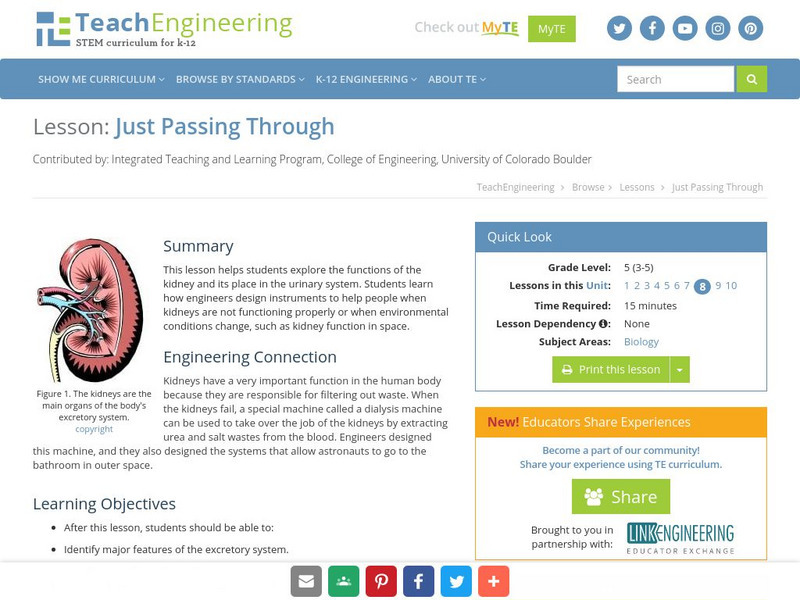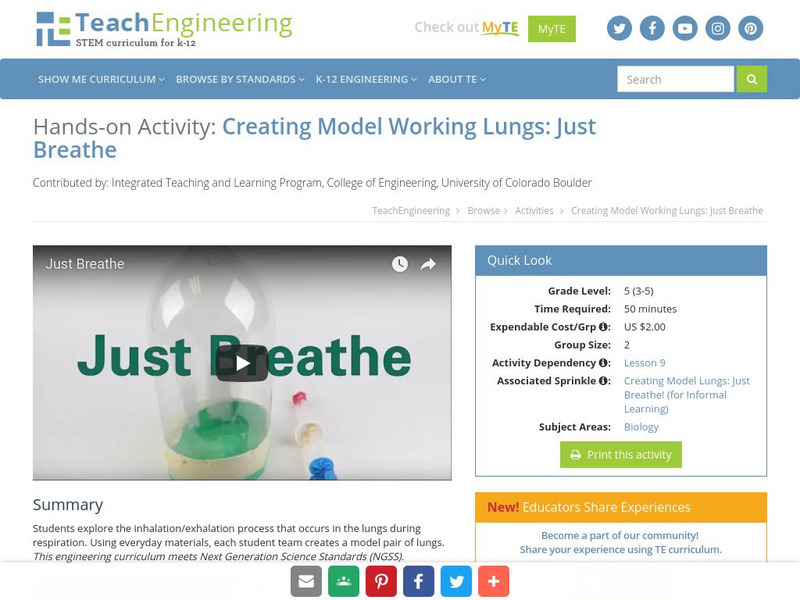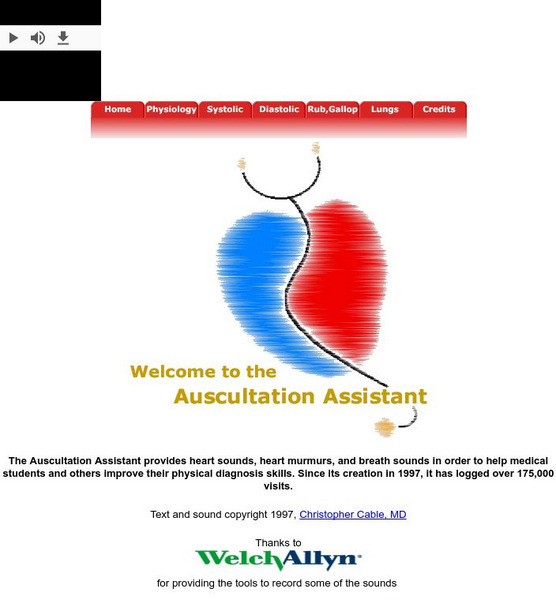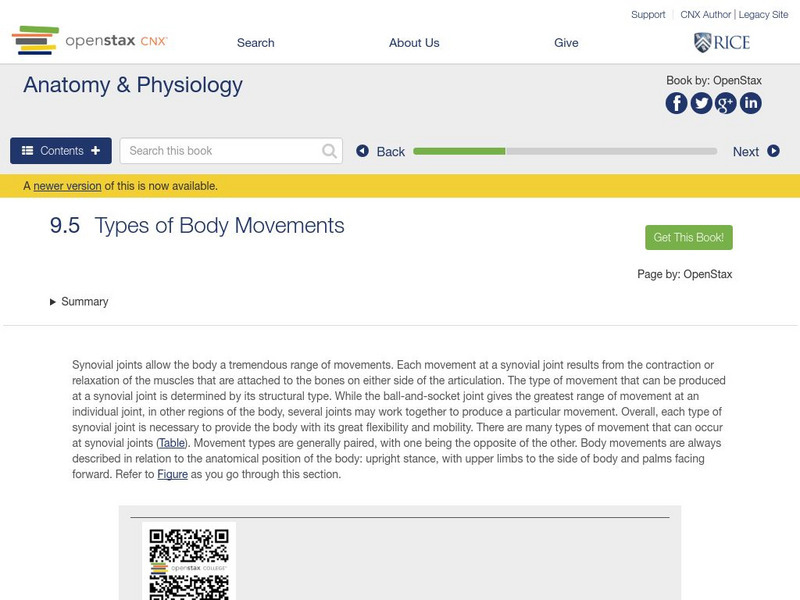Famous Scientists
Famous Scientists: Albrecht Von Haller
Read about the Swiss scientist sometimes referred to as the father of modern physiology.
University of Missouri
University of Missouri: Determining Age of Horses by Their Teeth
Can the age of horses be determined by looking at their teeth? Yes it can and this competent site explains how to do it.
TeachEngineering
Teach Engineering: Do You Have the Strength?
In this activity, students squeeze a tennis ball to demonstrate the strength of the human heart. Working in teams, they think of ways to keep the heart beating if the natural mechanism were to fail. The goal of this activity is to get...
TeachEngineering
Teach Engineering: Just Passing Through
This lesson helps students explore the functions of the kidney and its place in the urinary system. Students learn how engineers design instruments to help people when kidneys are not functioning properly or when environmental conditions...
TeachEngineering
Teach Engineering: Walk, Run, Jump!
In this activity, students participate in a series of timed relay races using their skeletal muscles. The compare the movement of skeletal muscle and relate how engineers help astronauts exercise skeletal muscles in space.
TeachEngineering
Teach Engineering: The Beat Goes On
In this activity, students learn about their heart rate and different ways it can be measured. Students construct a simple measurement device using clay and a toothpick, and then use this device to measure their heart rate under...
Inner Body
Innerbody: Diaphragm
This site from Innerbody.com has an illustration as well as detailed text explaining the function of the Diaphragm. See Images - Diaphragm and Descriptions - Diaphragm
TeachEngineering
Teach Engineering: Just Breathe
Students explore the inhalation/exhalation process that occurs in the lungs during respiration. Using everyday materials, they create a model pair of lungs.
Other
Whitman College: Virtual Fetal Pig Dissection
A supplement to lab dissections exploring introductory mammalian anatomy and physiology, for a fetal pig.
US National Library of Medicine
Medline Plus: Stress Echocardiography
A stress echocardiogram can help a doctor see how the heart responds to exercise. This tutorial explains how the test works and its risks and benefits.
Alabama Learning Exchange
Alex: The Virtual Knee Replacement Surgery
In this lesson, students will take on the role of the Surgeon throughout a total knee replacement surgery. Great lesson for an Anatomy and Physiology class with a focus on the Skeletal System.
Science Education Resource Center at Carleton College
Serc: A Comparative Approach to Animal Dissections (A Phylogenic Study)
In this biology inquiry lab, students study evolutionary relationships by making observations of preserved animal specimens, developing a question, then investigating by dissecting the specimens provided. This comparative approach offers...
University of Arizona
University of Arizona: Lung Toxicology Problem Set
This interactive module will help you understand the basic anatomy and physiology of the respiratory organs, primarily the lungs. You will learn about lung development, respiratory toxicology, secondhand tobacco smoke, asthma, and lung...
Stanford University
Sea Urchin Images
Free, downloadable images on a variety of topics related to urchin development, anatomy and physiology. Useful for teaching, worksheets and reports.
PBS
Pbs Teachers:kamchatka: Land of Abundant Salmon
Identify the three main groups of fishes and identify external and internal bony fish anatomy and physiology. Examine the Kamchatka ecosystem and the role of salmon in the food web, and describe the salmon spawning cycle.
University of California
The Auscultation Assistant
Designed for medical students, this site gives a detailed description of the sounds of the heart and lungs, including disorders, while playing read audio of those sounds with each description. Suitable for upper level high school...
OpenStax
Open Stax: Types of Body Movement
This site provides information regarding types of body movement. Movement types are generally paired, with one being the opposite of the other. Body movements are always described in relation to the anatomical position of the body:...
OpenStax
Open Stax: Skeletal Muscle
This site includes information about skeletal muscles, of which the best-known feature is its ability to contract and cause movement.
OpenStax
Open Stax: Smooth Muscle
This site provides an explanation of smooth muscle, muscle that is present in the walls of hollow organs like the urinary bladder, uterus, stomach, intestines, and in the walls of passageways, such as the arteries and veins of the...
OpenStax
Open Stax: Interactions of Skeletal Muscles
This site rpovides information regarding the interactions of skeletal muscles, including their fascicle arrangement and their lever systems.
Curated OER
Leffingwell and Associates: Olfaction
Provides a technical discussion of the anatomy and physiology involved in the receptors associated with the sense of smell. Includes pictures and formulas.
Curated OER
Leffingwell and Associates: Olfaction
Provides a technical discussion of the anatomy and physiology involved in the receptors associated with the sense of smell. Includes pictures and formulas.
Curated OER
Leffingwell and Associates: Olfaction
Provides a technical discussion of the anatomy and physiology involved in the receptors associated with the sense of smell. Includes pictures and formulas.
Curated OER
Leffingwell and Associates: Olfaction
Provides a technical discussion of the anatomy and physiology involved in the receptors associated with the sense of smell. Includes pictures and formulas.
Other popular searches
- Heart Anatomy and Physiology
- Anatomy and Physiology Web
- Plant Anatomy and Physiology
- Basic Anatomy and Physiology


















